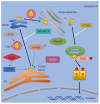When STING Meets Viruses: Sensing, Trafficking and Response
- PMID: 33133062
- PMCID: PMC7550420
- DOI: 10.3389/fimmu.2020.02064
When STING Meets Viruses: Sensing, Trafficking and Response
Abstract
To effectively defend against microbial pathogens, the host cells mount antiviral innate immune responses by producing interferons (IFNs), and hundreds of IFN-stimulated genes (ISGs). Upon recognition of cytoplasmic viral or bacterial DNAs and abnormal endogenous DNAs, the DNA sensor cGAS synthesizes 2',3'-cGAMP that induces STING (stimulator of interferon genes) undergoing conformational changes, cellular trafficking, and the activation of downstream factors. Therefore, STING plays a pivotal role in preventing microbial pathogen infection by sensing DNAs during pathogen invasion. This review is dedicated to the recent advances in the dynamic regulations of STING activation, intracellular trafficking, and post-translational modifications (PTMs) by the host and microbial proteins.
Keywords: DNA viruses; STING; cellular trafficking; immune responses; post translational modifications.
Copyright © 2020 Li, Cai, Sun, Li, Ding and Wang.
Figures


References
Publication types
MeSH terms
Substances
LinkOut - more resources
Full Text Sources
Medical
Molecular Biology Databases
Research Materials
Miscellaneous

